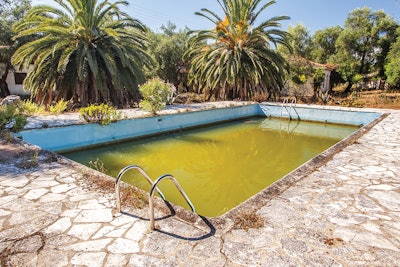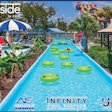
Regardless of water level, existing swimming pools that are not properly maintained can be considered abandoned.
There are a few categories of abandonment: temporary (closed for a short period of time, unused), neglected (the owner/operator is not maintaining the water quality), and indefinite (abandoned property).
A temporarily abandoned (or temporarily closed) pool can be caused by factors such as executive orders or emergency actions from federal, state or local authorities which could impact the use of aquatic facilities or residential swimming pools. They can also be caused by businesses and entities that may be temporarily closed. Additionally, condominiums and Homeowner Associations (HOAs) may be required to temporarily close pool and spa areas due to larger public health concerns, such as pandemics.
Any abandoned pool can create an ideal breeding and feeding ground for mosquitoes, which are notorious for carrying and transmitting the West Nile Virus and Zika Virus.
Hazards to avoid in temporarily abandoned pools include those previously mentioned and those associated with actively circulated water not being properly maintained.
PRECAUTIONS
A. Personal Safety
Do not swim in or use the pool, hot tub or spa that has been abandoned. Contaminated water can contain sewage, hazardous chemicals and / or disease-causing pathogens. Additionally, the pool water may become murky with algae, other microbial growth, and miscellaneous particulate contaminants. A turbid pool is a drowning hazard because a person in distress cannot be seen at the bottom of the pool.
Check the pool for wildlife. Often, when floodwaters recede, snakes and various types of wildlife are in swimming pools and other standing bodies of water. In the Southeastern United States, alligators displaced by floodwaters often take up residence in backyard swimming pools. If dangerous wildlife is present, immediately contact your local animal control or wildlife management department.
Drowning is a real danger. To prevent small children from wandering into the swimming pool area and unintentionally falling into the pool— or tripping on hazards around the swimming pool area — use a temporary safety fence or other approved barrier to block entry to the pool area.
Check with your county or local municipality for existing laws and regulations regarding minimum standards for barrier construction. Pool covers are not universally accepted as effective barriers. Generally, bolted or otherwise secured covers which comply with the ASTM F1346-91 Standard are recommended to prevent additional debris from entering the pool or unsupervised children from accessing the pool. Heavy rainfall can cause standing water to collect on solid covers. There should be a means, such as a pump, to remove standing water from the cover within 30 minutes after a downpour. Loose covers (such as floating or solar covers) or damaged covers are not recommended, as they tend to collapse, retain water, and create a drowning hazard. Take measures to prevent insects from breeding in the swimming pool or spa water. Water that is not being actively treated with sanitizer can serve as an ideal habitat for disease-carrying mosquitoes. Serious diseases — such as the West Nile virus, the Zika virus, dengue fever, and chikungunya — can be transmitted through infected mosquitos.
An addition of a larvicide or pesticide to the water may help reduce or prevent mosquito infestation. When using a larvicide or pesticide, always carefully follow the label instructions or secure the services of a licensed pesticide professional. Do not use the pool or spa which has been treated with larvicides. The swimming pool should be drained and refilled after this treatment.
Many jurisdictions require by law that pools with no covering, or insufficient covering that is not being disinfected and filtered, be drained and filled with clean dirt, treated with a larvicide, or stocked with native fish species approved by the state or local municipality. Check with your local officials to determine specific requirements.
B. Electrical Safety
Electrocution is a real and present danger. Prior to beginning any clean-up efforts, make certain that the power to all pool and spa equipment, heaters, outdoor lighting fixtures, outlets, and appliances are turned off at the main circuit breaker or fuse box utilizing a Lock-Out Tag Out system for added protection. This is to ensure that no one can turn the breakers back on during repairs. Do not touch a circuit breaker or fuse with wet hands or while standing on a wet surface or in standing water. Reset breakers using a dry plastic- or rubber-insulated tool using only a single hand. If the main circuit breaker or fuse box is inaccessible or damaged, or you have any questions, immediately contact a licensed electrician to repair the damage prior to beginning any clean-up activities.
C. Chemical Safety
All pool chemicals in storage areas should be properly disposed of according to the manufacturer's label or state and local regulations. If chemicals were moistened, contaminated, or mixed in an uncontrolled manner during or after a flooding event, violent reactions (explosions, fire and/or release of toxic fumes) may occur. Contact your local fire department or call CHEMTREC, a public service hotline during chemical and hazardous materials incidents, at 1(800)262-8200. Be prepared to provide the names and amounts of chemicals involved. Never touch any compromised containers of chemicals without wearing gloves, eye goggles, and other protective equipment.
Without proper pool maintenance (which includes circulation and treatment of water), various pathogens, such as Pseudomonas, can be blown into the pool and grow. It can also create a breeding ground for mosquitoes, other pests and the diseases they may carry. This presents a risk not only to bathers but to the entire community at large.
A working circulating pump is necessary for proper pool filtration and sanitation, as well as for the control of mosquito-borne pathogens such as West Nile Virus (see Tech Notes: West Nile Virus, Nov. 2019 AQUA, or visit aqmag.co/westnilevirus).
Mosquitoes lay eggs in standing water. This can happen nearly anywhere; however, mosquito larvae need to consume organic matter and microorganisms in order to mature to adulthood; and these are abundant in abandoned, unfiltered and untreated pools.
Most people who contract West Nile Virus will develop West Nile Fever, which is relatively mild and unlikely to require medical attention. Symptoms include a low-grade fever, body aches, headache, and fatigue. A lesser number of infected people (about 1 in 150)will develop West Nile Encephalitis or West Nile Meningitis, which can result in high fever, confusion, convulsions, severe headache, partial paralysis, inflammation of the brain, swelling of the spinal cord, and even death.
CONCLUSION
A well-maintained pool eliminates food sources for mosquito larvae and therefore, reduces the proliferation of mosquitoes, the West Nile Virus and Zika Virus.
It is recommended that the following precautions be taken by homeowners and commercial pool operators when encountering any type of abandoned pool:
- Maintain the chemical manufacturer-recommended levels of sanitizer in pools. This controls microorganisms, which may serve as food for mosquito larvae.
- Ensure that filters are working properly.
- Regularly skim the water, vacuum, scrub and brush the surface as well as clean the filter to eliminate any organic matter.
- Conduct testing to ensure proper water balance.
- Drain, clean and cover (or backfill) indefinitely abandoned pools, to prevent refilling with rainwater that becomes stagnant, creating mosquito-breeding surfaces.
- Empty other water-holding structures, such as bird baths, flowerpots and pool covers, to discourage the proliferation of mosquito populations on the property.
Temporarily abandoned pools should be maintained according to current public health guidelines, standards and / or regulations. When conducting indefinitely abandoned-pool cleanup, the wearing of mosquito-resistant clothing and mosquito-repellent containing DEET is recommended. It is also best to perform cleanup operations during daylight hours, since mosquitoes tend to bite after dark.
REFERENCES
- ASTM F1346-91 Standard Performance Specification for Safety Covers and Labeling Requirements for All Covers for Swimming Pools, Spas and Hot Tubs, www.astm.org/
- CHEMTREC, www.chemtrec.com/
- PHTA The West Nile Virus and Its Impact on Pools and Spas Fact Sheet, Pool & Hot Tub Alliance, 2020, www.phta.org, www.phta.org/standards-and-codes/fact-sheets/water-quality/
- PHTA Abandoned Pools Fact Sheet, Pool & Hot Tub Alliance, www.phta.org, 2020, www.phta.org/standards-and-codes/fact-sheets/water-quality/
- PHTA Flooded Swimming Pools and Spas Fact Sheet, Pool & Hot Tub Alliance, 2017, www.phta.org, www.phta.org/standards-and-codes/fact-sheets/water-quality/
- CPO Pool and Spa Operator Handbook, Pool Hot Tub Alliance, 2022, pp.192-193
This article first appeared in the July 2023 issue of AQUA Magazine — the top resource for retailers, builders and service pros in the pool and spa industry. Subscriptions to the print magazine are free to all industry professionals. Click here to subscribe.











































